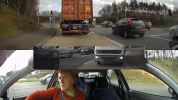I have a broken Vanture N2 Pro that records at 170 deg. I like how wide it can see. But since my bad experience was Vanture, I'm looking to get a cheaper dash cam.
I'm not looking at Viofo because they look to have excellent reviews for their price range, but I see they have 3 difference A119 models. Each has a different field of view. 160, 135, 130.
My question is, is there much of a difference? With the 170 on the N2 Pro, using the suction mount, I could see the A pillars of the car. Will I get that or close to it with something like the A119 Pro, which only sees at 130?
Thanks!
I'm not looking at Viofo because they look to have excellent reviews for their price range, but I see they have 3 difference A119 models. Each has a different field of view. 160, 135, 130.
My question is, is there much of a difference? With the 170 on the N2 Pro, using the suction mount, I could see the A pillars of the car. Will I get that or close to it with something like the A119 Pro, which only sees at 130?
Thanks!


